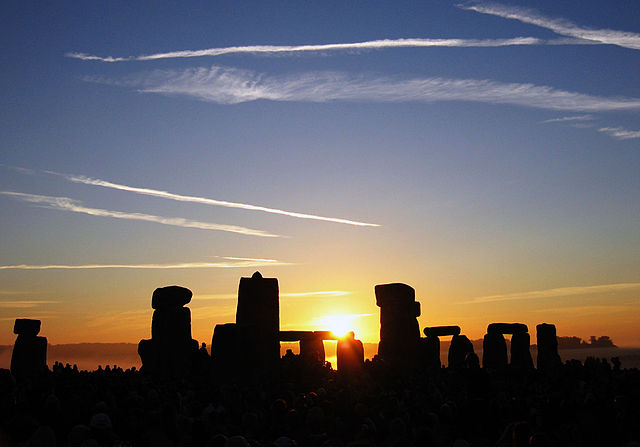 |
This is a file from the Wikimedia Commons. Information from its description page there is shown below.
Commons is a freely licensed media file repository. You can help.
|
 |
This is a featured picture, which means that members of the community have identified it as one of the finest images on the English Wikipedia, adding significantly to its accompanying article. If you have a different image of similar quality, be sure to upload it using the proper free license tag, add it to a relevant article, and nominate it. |
 |
This image was selected as picture of the day on the English Wikipedia for September 10, 2005. |
The Sun rising over Stonehenge on the morning of the Summer Solstice (21st June 2005).
A crowd of between 14,000 and 19,000 people watched the sunrise from the ground, along with three paramotor pilots who watched the events from the air.
This photograph was taken a couple of minutes after sunrise, and a little to the right of the solar alignment line. A more perfectly aligned photograph taken immediately after sunrise can be seen at Image:Summer Solstice 2005 Sunrise over Stonehenge 01.jpg.
Description of the solar alignment
If you look at an aerial view, north is approximately along the path to the right. On the morning of the solstice, the sun rises from behind the Heel Stone in the bottom right hand corner, and can be observed on an alignment running from the Heel stone, passing between the two Slaughter Stones (only one remains fallen on the outer bank), through the outer Sarsen ring, across the centre of the henge, then between the tallest trilith at the back of the Sarsen horseshoe. If you continue the line onward to the bank and ditch top left, that's the point from which this photo is taken.
Tallest stone
Today the tallest trilith at the back of the Sarsen horseshoe is largely collapsed. Only one of its three stones remains standing, which is the tallest stone just left of the sun in this photograph.
The lintel stones on the triliths and the outer Sarsen circle are held in place with mortise and tenon joints. I believe the triangular spike on top of the tallest stone, is the tenon exposed after its neighbouring stones had fallen.
Keywords: Summer Solstice, Stonehenge
| Photograph Andrew Dunn, 21 June 2005. |
| Website: http://www.andrewdunnphoto.com/ |
|
I, the copyright holder of this work, hereby publish it under the following license:
|
|
|
|
Camera location
|
51° 10′ 42.50″ N, 1° 49′ 37.82″ W
|
This and other images at their locations on: Google Maps - Google Earth - OpenStreetMap |
( Info)51.178472222222;-1.8271722222222 |
File usage
The following pages on Schools Wikipedia link to this image (list may be incomplete):
Wikipedia for Schools was collected by SOS Childrens Villages. SOS Children is famous for the love and shelter it brings to lone children, but we also support families in the areas around our Children's Villages, helping those who need us the most. Why not try to learn more about child sponsorship?



